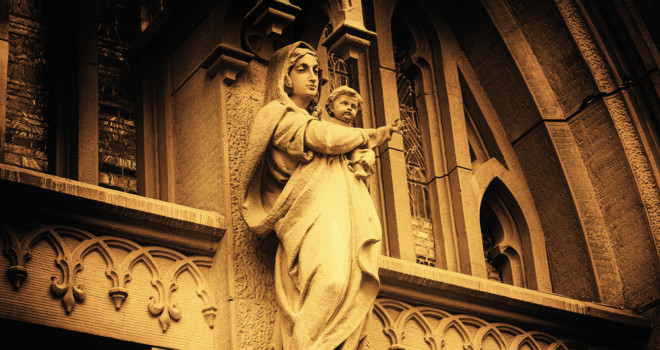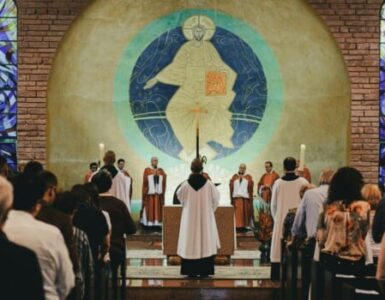‘Our Lady is more Mother than Queen.’
– St. Therese of Lisieux
But she is Queen nonetheless.
Her very name tells us that. St. Jerome makes the following statement while offering various interpretations of Mary’s name: ‘We should realize that Mary means Lady in the Syrian Language.’ St. Chrysologus states more explicitly: ‘The Hebrew word Mary means Domina. The Angel therefore addresses her as “Lady” to preclude all servile fear in the Lord’s Mother’: the Archangel Gabriel’s heavenly voice, then, is the first to proclaim Mary’s royal office.
From earliest times, the Christians of both East and West have acclaimed their Queen. Over the centuries, Christian artists have tried faithfully to interpret and express this aspect of devotion to the Virgin. Indeed, since the Council of Ephesus (431), Mary has been portrayed as Queen and Empress. In art works, she rules as one seated upon a throne adorned with royal insignia; surrounded by the heavenly host of angels and saints, the divine Redeemer crowns His mother with a resplendent diadem. She rules not only over nature, but also – and today it is good to be reminded of this – over Satan.
With devotion to the Queenship of Our Lady having such a long historical pedigree, it comes as a surprise to learn that the feast itself is of recent origin. The encyclical that instituted the feast, Ad Caeli Reginam, was given by Pope Pius XII at Rome on 11 October 1954. In it, the pope urged all Christians to glory in ‘being subjects of the Virgin Mother of God, who, while wielding royal power, is on fire with a mother’s love’.
The encyclical came at a crucial time. The Cold War continued apace, with the errors of Communism gaining year by year as the iron grip of Moscow tightened on the once Christian lands of Europe. The Supreme Pontiff did not forget the Christian peoples then imprisoned in a political system that persecuted those who remained faithful to their Lord and Queen:
In some countries of the world there are people who are unjustly persecuted for professing their Christian faith and who are deprived of their divine and human rights to freedom; up till now reasonable demands and repeated protests have availed nothing to remove these evils’.
Yet, Pope Pius XII went on to say this:
May the powerful Queen of creation, whose radiant glance banishes storms and tempests and brings back cloudless skies, look upon these her innocent and tormented children with eyes of mercy; may the Virgin, who is able to subdue violence beneath her foot, grant to them that they may soon enjoy the rightful freedom to practice their religion openly, so that, while serving the cause of the Gospel, they may also contribute to the strength and progress of nations by their harmonious cooperation, by the practice of extraordinary virtues which are a glowing example in the midst of bitter trials.
It is a prayer as much as a theological statement. In the face of one of the most relentless and merciless persecutions of Christians ever known, the Supreme Pontiff cried out to the Queen of Heaven to act.
At the start of the 20th Century, it had been from the East that the persecution had come. Yet, there were other, older voices from that same Christian East that had once proclaimed: ‘O Mother of God, today thou art carried into heaven on the chariots of the cherubim, the seraphim wait upon thee and the ranks of the heavenly army bow before thee.’ (Ex liturgia Armenorum: in festo Assumptionis, hymnus ad Matutinum.)
It was a Royal power that was being invoked by the Pope, and, as this prayer ascended, a Heavenly Army stirred…
*
In October 1917, in an orgy of violence and bloodletting, the Bolsheviks seized power in Moscow, and Holy Russia was no more. At the same time, in a remote part of Portugal, three peasant children were being told of a very different revolution that, in the end, would triumph.
Decades later, in 1980, on the eve of the feast of the Assumption, in Poland’s Gdańsk Shipyard, a number of workers went on strike on account of the sacking of a worker who had tried to start a trade union. This led to the founding of the independent trade union, Solidarity. It also led to attempts by the Polish Communist State to destroy that union and liquidate all those involved; there were increasingly ominous threats of a Soviet invasion if this did not happen. Against the odds, Solidarity stood firm, and, ultimately, prevailed; thereafter, as the Communist control of Poland weakened, some glimpsed another, very different, and much more powerful force at work.
Few in the West had noticed that when the shipyard had been occupied by the striking workers, encircled by the increasingly menacing forces of the Communist state, those besieged inside had placed at the yard’s gates a symbol of faith, one asking for protection: it was an image of Our Lady of Częstochowa – Queen and Protector of Poland.
As subsequent events would show, this was never simply a political struggle.
In 1990, on the day after the feast of the Immaculate Conception, Lech Walesa was duly elected President of a newly liberated Poland –upon his lapel was pinned the image of the Madonna of Częstochowa.
Subsequently, further east, a sequence of events followed that, with lightening speed, gave a definitive answer to the prayer of Pope Pius XII and revealed the true Sovereign.
On August 22, 1991, the feast of the Queenship of Mary, a military coup against the reforms inside the Soviet Union was crushed. Thereafter, with all attempts at a Communist restoration foiled, the fate of the Soviet Communist Party was sealed.
On December 8, 1991, Solemnity of the Immaculate Conception of Mary, it was announced that the Community of Independent States would replace the political entity known as the Union of Soviet Socialist Republics (USSR).
On December 12, the feast of Our Lady of Guadalupe, the Supreme Soviet of Russia formally ratified the Belavezha Accords and renounced the Union Treaty that had brought the USSR into existence in 1922.
On December 25, 1991, Solemnity of the Birth of the King of kings, the Supreme Soviet of Russia adopted a statute to change Russia’s legal name from Russian Soviet Federative Socialist Republic to Russian Federation, ending any link with Communism. At 7:32 p.m., the Hammer & Sickle flag was lowered at the Kremlin for the last time.
On January 1, 1992, Solemnity of Mary, Mother of God, the principal Marian feast of the liturgical calendar, Russia emerged as an independent state, once more open to religious freedom.
The bitter trial ended, the atheistic Soviet Union was no more; and, with that, the 1917 Bolshevik Revolution of Lenin, Trotsky, Stalin and millions of innocent dead was now, finally, over.
The worldwide revolution pertaining to the Immaculate Heart, announced at Fatima in 1917, was, however, just beginning.
*
On 13 May 1982, the feast of Our Lady of Fatima, the first anniversary of what many contend was an Eastern Bloc orchestrated assassination attempt on the life of the pontiff, Pope John Paul II travelled to the Portuguese shrine.
In the crown of the statue of Our Lady of Fatima, the Pontiff placed one of the bullets that had been removed from his body at Rome’s Gemelli Hospital the previous year. Then, pausing to reflect on all that had happened, he summed up his view of life and history:
‘…in the designs of Providence there are no mere coincidences.’














